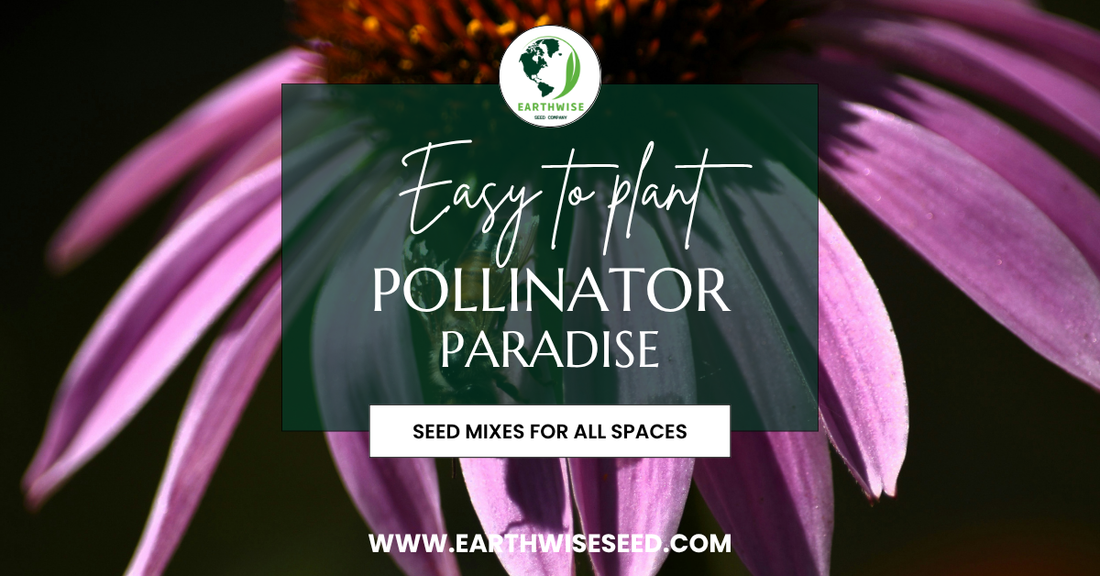It’s Pollinator Week, and we’re celebrating the small but mighty species that keep our ecosystems thriving. From bees and butterflies to hummingbirds and beetles, pollinators play a vital role in plant reproduction, biodiversity, and food production. But their populations are declining, and the solution starts in your own yard.
The good news? You don’t need acres of land to make a difference. You just need a few square feet, a patch of sun, and the right seed mix.
Why Plant a Pollinator Garden?
Pollinators rely on native flowering plants for food and shelter. By planting a pollinator garden with native wildflowers and grasses, you create a habitat that:
-
Provides nectar and pollen throughout the growing season
-
Supports pollinators at all life stages
-
Helps restore local ecosystems
-
Adds beauty and color to your landscape
How to Plant a Pollinator Garden
Whether you're converting a corner of your lawn or going all-in on your front yard, planting for pollinators is easier than you think.
1. Pick the Right Spot
Choose an area with:
- At least 6+ hours of sun per day
-
Good drainage
-
Minimal foot traffic and as much native potential as possible
2. Prepare the Area (or Overseed)
Depending on your current landscape, you can either start fresh or overseed:
If preparing bare ground:
- Remove grass, mulch, or weeds
-
Lightly loosen or rake the top inch of soil
If overseeding into existing lawn or patchy areas:
-
Mow the area as short as possible
-
Rake or rough up the soil to expose some bare spots
-
Water the area well before seeding
Either method works — the key is good seed-to-soil contact and giving your seeds room to grow.
3. Sow Your Seeds
Use a native seed mix designed to support pollinators—like our Pollinator Paradise Native Seed Mix, which contains native wildflowers and grasses.
-
Broadcast evenly over your prepared area
-
For best coverage, mix seed with sand or sawdust to help distribute it
-
Do not bury the seeds — many native species need sunlight to germinate
-
Gently press the seeds into the soil using a roller or by walking over the area
Pro Tip: Use Seed Tac to Lock It In
To keep your seeds in place and boost germination, we recommend pairing your mix with our Seed Tac — a natural tackifier made from plant-based ingredients.
Why use Seed Tac?
-
Helps seeds stick to the soil
-
Reduces seed washout from wind or rain
-
Improves moisture retention for better germination
-
Especially helpful on slopes, bare patches, or compacted soil
Simply mix it with water and apply it over your seeded area using a sprayer or watering can. It’s non-toxic and safe for people, pets, and pollinators.
👉 Add Seed Tac to Your Order Here
4. Water Wisely
-
Water daily (or as needed) until seedlings emerge and become established
-
After that, native plants need little to no supplemental watering — they’re built to survive with natural rainfall
5. Be Patient
Native plants take time to settle in. You may see blooms in the first season, but most mixes reach full beauty and pollinator activity by the second year. It's worth the wait — these are perennials and will come back stronger year after year.
What’s in Our Pollinator Paradise Mix?
Our Pollinator Paradise Native Seed Mix is hand-selected for beauty, biodiversity, and regional adaptability. It includes:
-
Native wildflowers like Black-Eyed Susan, Lemon Mint, Indian Blanket, and Partridge Pea
-
Native grasses that provide structure and support for nesting pollinators
-
Year-round blooms to keep nectar and pollen flowing
And right now — in honor of Pollinator Week — it’s 30% off with code: BUZZ30
Ready to Get Growing?
Whether you’re new to native gardening or a seasoned grower, your yard can be part of the solution.
Big or small, every pollinator patch matters.
👉 Shop the Pollinator Paradise Mix – Now 30% Off
📌 Save & Share
If this guide helped, bookmark it or share it with a friend who’s looking to do something meaningful with their lawn.
Because Pollinator Week is more than awareness—it’s a call to action.

